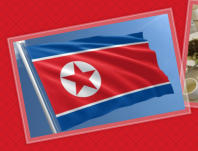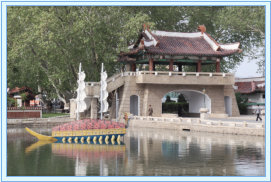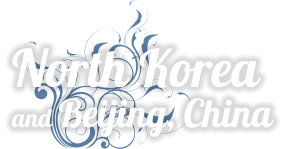



© Nova Fisher novatravels.net

Kaesong
Kaesong, the only major city that changed hands between North and South Korea
as a result of the Korean War.
Kaesong Koryo Museum
The former 992 AD Confucian Sungyun academy is now a small museum of the Koryo Dynasty (918-1392 AD) exhibiting historical objects, statues, pagodas, and porcelain from that time. Set amongst greenery there are one thousand-year-old ginkgo and zelkova trees in the courtyard. The academy still exists today in the form two successor universities: the Kaesong University of Light Industry in North Korea and Sungkyunkwan University in South Korea. This lineage is considered one of the oldest continuous educational institutes in the world. There is an exhibit of old guns and I was told that the Koreans were the inventors of gunpowder in the 12th Century (I understood that the Chinese invented it and my later research says - “The discovery of gunpowder is attributed to experimentation in Chinese alchemy by Taoists in the pursuit of immortality, and is popularly listed as one of the "Four Great Inventions" of China. These four are the compass, gunpowder, papermaking and printing.” There was a painting on the wall showing some ladies on a seesaw and I was told that the see- saw originated here as the ladies were raised higher on one side of the plank so they could see over the wall. We visited the store at the entrance that sells souvenirs, stamps, postcards, local ginseng, etc. Nam Gate (South Gate) Built between 1391 and 1393, at the same time as the inner citadel of the walled city Nam Gate is the only surviving gate of the seven gates built. During the Korea War it was severely damaged but rebuilt in 1954. It still contains the 14 ton Yŏnbok bell cast in 1346.Tan Gon (WanGon) Tomb
The tomb of Tan Gon (Wang Gon) and his wife, Adyu. Tan Gon (877-943) was the founder of the Goryeo Dynasty and 1st King of the unified Federal state of Korea. The original tomb was badly damaged by the end of the Japanese occupation, so most of the site today is apparently recently reconstructed. The tomb is protected by 12 guardian gods with animal heads, 2 council officers and 4 guards. A small museum displays artifacts from Tan Gun times. I was told that Tan Gon’s ashes were found in 1993 and his DNA was identified as being 5011 years old. It was later claimed that he was a member of the ‘Kim’ family. There is a village near the tomb where, apparently, all relatives with the name of Wang (Tan) are housed. The village was built in 1992. Sariwon City From Kaesong, we drove back north for 1.5 hours to Sariwon City, the provincial seat of South Pyongyan Province. The "Sariwŏn Folklore street" was constructed during Kim- Jong-il's rule. Built to display an ideal picture of ancient Korea, it includes buildings in the "historical style" and a collection of ancient Korean cannons. It is considered an inaccurate romanticized recreation of an ancient Korean street.Migok Co-Operative Farm
Situated near Sariwon and created as a model farm to the rest of the country, I was told that Kim Il Song visited 16 times. Kim Jong Il visited 8 times with the last time being in 2006. Kim Jong Un has not visited. I visited a simple farmer’s home which had, apparently been visited by Kim Il Sung and there was a photo on the wall of his visit, along with other photos and blessings to the Kim family. I was surprised to see the cooker just above ground level. The cook sits on the floor and shuffles on her bottom between the pans and the cooker. I’ve not seen that before and can’t imagine how difficult that is with hot pans. I then visited the farm in the Chaeryong Plains, one of the DPRK’s main agricultural regions. We were joined by a guide who told us that the Migok Co-operative has 1000 workers in 17 workteams with 10 areas of rice (750 hectares) and 7 of vegetables (50 hectares) plus an area of fruit (30 hectares). Before liberation the yield was 1 ton per hectare and now it is 10 tons per hectare. There was very little farm equipment to be seen in the fields.



Kaesong City
Located just north of the Korean DMZ, Kaesong was the ancient capital of the Koryo Dynasty (918–1392 BC). The street lights are powered by solar panels and most of the apartments have solar panels hanging off the windows - an indication of an unreliable power supply. With its topography, climate and soil, Kaesong has advantageous conditions for agricultural production. Rice, maize, wheat, soybeans and barley are the main crops. The area is known for cultivating the quality Korean ginseng called Goryeo Insam. I was told that Ginseng originated here. Kaesong has many cyclists and few cars. In 2005, North & South Korea jointly operated an industrial complex in the Kaesong Industrial Region. In 2012 there were over 53,000 North Korean workers, typically working for about 20% of the South Korean minimum wage, in lots of textile and other labour intensive factories operated by more than 120 South Korean companies. In April 2013, North Korea recalled all 53,000 North Korean workers from the Kaesong Industrial complex, effectively suspending all of its operations. In response, South Korea withdrew all of its citizens working in Kaesong and threatened to give up on the venture. Following failed negotiations, on February 10, 2016, the South Korean Ministry of Unification shut down the joint project as the South Korean government believes it is serving as a source of hard currency to bankroll the North's nuclear weapons programme.Sonjuk Bridge
The small stone bridge, built in 1290 is 7m long and 2.5m wide. Lee Bang Won, the third king of the Chosun Dynasty and son of first king of that dynasty, had his opponent Jong Mong Ju executed on this bridge in 1392. It is named after a bamboo that grew where he was killed.Korean Royal Lunch
I went to the Kaesong Folk Hotel for a traditional Korean Royal Lunch ‘pansanggi’, where 12 dishes are served in small gold bowls. Unfortunately, the food was spicy so I couldn’t eat much of it. The Hotel has 19 traditional hanok-style courtyard houses, many of which date to the Joseon Dynasty and retain their original furnishings.










Click on any photo to see a slideshow of larger versions




© Nova Fisher novatravels.net
Kaesong
Kaesong, the only major city that changed
hands between North and South Korea as a
result of the Korean War.
Kaesong
Koryo
Museum
The former 992 AD Confucian Sungyun academy is now a small museum of the Koryo Dynasty (918-1392 AD) exhibiting historical objects, statues, pagodas, and porcelain from that time. Set amongst greenery there are one thousand- year-old ginkgo and zelkova trees in the courtyard. The academy still exists today in the form two successor universities: the Kaesong University of Light Industry in North Korea and Sungkyunkwan University in South Korea. This lineage is considered one of the oldest continuous educational institutes in the world. There is an exhibit of old guns and I was told that the Koreans were the inventors of gunpowder in the 12th Century (I understood that the Chinese invented it and my later research says - “The discovery of gunpowder is attributed to experimentation in Chinese alchemy by Taoists in the pursuit of immortality, and is popularly listed as one of the "Four Great Inventions" of China. These four are the compass, gunpowder, papermaking and printing.” There was a painting on the wall showing some ladies on a seesaw and I was told that the see-saw originated here as the ladies were raised higher on one side of the plank so they could see over the wall. We visited the store at the entrance that sells souvenirs, stamps, postcards, local ginseng, etc. Nam Gate (South Gate) Built between 1391 and 1393, at the same time as the inner citadel of the walled city Nam Gate is the only surviving gate of the seven gates built. During the Korea War it was severely damaged but rebuilt in 1954. It still contains the 14 ton Yŏnbok bell cast in 1346.Tan Gon
(WanGon)
Tomb
The tomb of Tan Gon (Wang Gon) and his wife, Adyu. Tan Gon (877-943) was the founder of the Goryeo Dynasty and 1st King of the unified Federal state of Korea. The original tomb was badly damaged by the end of the Japanese occupation, so most of the site today is apparently recently reconstructed. The tomb is protected by 12 guardian gods with animal heads, 2 council officers and 4 guards. A small museum displays artifacts from Tan Gun times. I was told that Tan Gon’s ashes were found in 1993 and his DNA was identified as being 5011 years old. It was later claimed that he was a member of the ‘Kim’ family. There is a village near the tomb where, apparently, all relatives with the name of Wang (Tan) are housed. The village was built in 1992. Sariwon City From Kaesong, we drove back north for 1.5 hours to Sariwon City, the provincial seat of South Pyongyan Province. The "Sariwŏn Folklore street" was constructed during Kim-Jong-il's rule. Built to display an ideal picture of ancient Korea, it includes buildings in the "historical style" and a collection of ancient Korean cannons. It is considered an inaccurate romanticized recreation of an ancient Korean street.Migok Co-
Operative Farm
Situated near Sariwon and created as a model farm to the rest of the country, I was told that Kim Il Song visited 16 times. Kim Jong Il visited 8 times with the last time being in 2006. Kim Jong Un has not visited. I visited a simple farmer’s home which had, apparently been visited by Kim Il Sung and there was a photo on the wall of his visit, along with other photos and blessings to the Kim family. I was surprised to see the cooker just above ground level. The cook sits on the floor and shuffles on her bottom between the pans and the cooker. I’ve not seen that before and can’t imagine how difficult that is with hot pans. I then visited the farm in the Chaeryong Plains, one of the DPRK’s main agricultural regions. We were joined by a guide who told us that the Migok Co- operative has 1000 workers in 17 workteams with 10 areas of rice (750 hectares) and 7 of vegetables (50 hectares) plus an area of fruit (30 hectares). Before liberation the yield was 1 ton per hectare and now it is 10 tons per hectare. There was very little farm equipment to be seen in the fields.








Kaesong City
Located just north of the Korean DMZ, Kaesong was the ancient capital of the Koryo Dynasty (918–1392 BC). The street lights are powered by solar panels and most of the apartments have solar panels hanging off the windows - an indication of an unreliable power supply. With its topography, climate and soil, Kaesong has advantageous conditions for agricultural production. Rice, maize, wheat, soybeans and barley are the main crops. The area is known for cultivating the quality Korean ginseng called Goryeo Insam. I was told that Ginseng originated here. Kaesong has many cyclists and few cars. In 2005, North & South Korea jointly operated an industrial complex in the Kaesong Industrial Region. In 2012 there were over 53,000 North Korean workers, typically working for about 20% of the South Korean minimum wage, in lots of textile and other labour intensive factories operated by more than 120 South Korean companies. In April 2013, North Korea recalled all 53,000 North Korean workers from the Kaesong Industrial complex, effectively suspending all of its operations. In response, South Korea withdrew all of its citizens working in Kaesong and threatened to give up on the venture. Following failed negotiations, on February 10, 2016, the South Korean Ministry of Unification shut down the joint project as the South Korean government believes it is serving as a source of hard currency to bankroll the North's nuclear weapons programme.Sonjuk Bridge
The small stone bridge, built in 1290 is 7m long and 2.5m wide. Lee Bang Won, the third king of the Chosun Dynasty and son of first king of that dynasty, had his opponent Jong Mong Ju executed on this bridge in 1392. It is named after a bamboo that grew where he was killed.Korean Royal Lunch
I went to the Kaesong Folk Hotel for a traditional Korean Royal Lunch ‘pansanggi’, where 12 dishes are served in small gold bowls. Unfortunately, the food was spicy so I couldn’t eat much of it. The Hotel has 19 traditional hanok-style courtyard houses, many of which date to the Joseon Dynasty and retain their original furnishings.
































